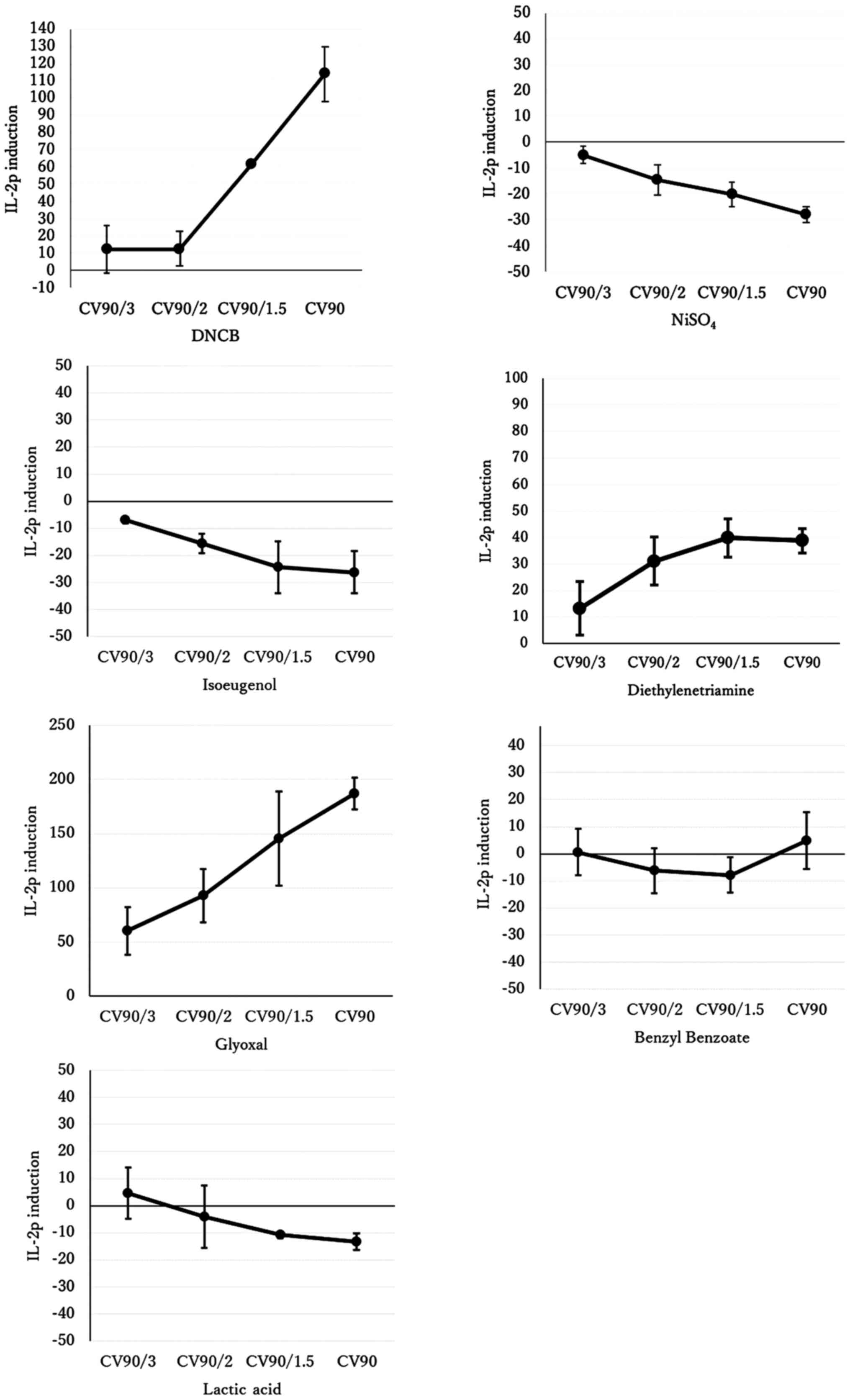|
1
|
van Vliet E, Kühnl J, Goebel C,
Martinozzi-Teissier S, Alépée N, Ashikaga T, Blömeke B, Del Bufalo
A, Cluzel M, Corsini E, et al: State-of-the-art and new options to
assess T cell activation by skin sensitizers. ALTEX. 35:179–192.
2018.PubMed/NCBI View Article : Google Scholar
|
|
2
|
Qin R and Lampel HP: Review of
occupational contact dermatitis - Top allergens, best avoidance
measures. Curr Treat Options Allergy. 2:349–364. 2015.
|
|
3
|
Organisation for Economic Co-operation and
Development: The Adverse Outcome Pathway for Skin Sensitisation
Initiated by Covalent Binding to Proteins. Available from:
https://doi.org/10.1787/9789264221444-en.
|
|
4
|
Organisation for Economic Co-operation and
Development: Test No. 406: Skin Sensitisation. 1992. Available
from: https://doi.org/10.1787/9789264070660-en.
|
|
5
|
Organisation for Economic Co-operation and
Development: Test No. 429: Skin Sensitisation. 2010. Available
from: https://doi.org/10.1787/9789264071100-en.
|
|
6
|
Herrmann K, Pistollato F and Stephens ML:
Beyond the 3Rs: Expanding the use of human-relevant replacement
methods in biomedical research. ALTEX. 36:343–352. 2019.PubMed/NCBI View Article : Google Scholar
|
|
7
|
European Commision: Ban on Animal Testing:
Internal Market, Industry, Entrepreneurship and SMEs. Available
from: https://ec.europa.eu/growth/sectors/cosmetics/animal-testing_en.
|
|
8
|
Organisation for Economic Co-operation and
Development: Test No. 442C: In Chemico Skin Sensitisation. 2020.
Available from: https://doi.org/10.1787/9789264229709-en.
|
|
9
|
Organisation for Economic Co-operation and
Development: Test No. 442D: In Vitro Skin Sensitisation. 2018.
Available from: https://doi.org/10.1787/9789264229822-en.
|
|
10
|
Organisation for Economic Co-operation and
Development: Test No. 442E: In Vitro Skin Sensitisation. 2018.
Available from: https://doi.org/10.1787/9789264264359-en.
|
|
11
|
Hou F, Xing C, Li B, Cheng J and Chen W:
Performance of a novel in vitro assay for skin sensitization based
on activation of T lymphocytes. ALTEX. 37:451–468. 2020.PubMed/NCBI View Article : Google Scholar
|
|
12
|
Croft M and Dubey C: Accessory molecule
and costimulation requirements for CD4 T cell response. Crit Rev
Immunol. 37:261–290. 2017.PubMed/NCBI View Article : Google Scholar
|
|
13
|
Abbas AK, Trotta E, Simeonov DR, Marson A
and Bluestone JA: Revisiting IL-2: Biology and therapeutic
prospects. Sci Immunol. 3(eaat1482)2018.PubMed/NCBI View Article : Google Scholar
|
|
14
|
Claesson MH, Dissing S, Tscherning T and
Geisler C: T-cell activation. V. Anti-major histocompatibility
complex class I antibody-induced activation and clonal abortion in
Jurkat T-leukaemic cells. Immunology. 78:444–448. 1993.PubMed/NCBI
|
|
15
|
Stecha P, Grailer J, Cheng JJ, Hartnett J,
Fan F and Stecha MC: American Association of Cancer Research
(AACR): Abstract 5439: Development of a robust reporter-based
T-cell activation assay for bispecific therapeutic antibodies in
immunotherapy. Cancer Ref: Aug 12, 2015 (Epub ahead of print).
|
|
16
|
Takenouchi O, Fukui S, Okamoto K, Kurotani
S, Imai N, Fujishiro M, Kyotani D, Kato Y, Kasahara T, Fujita M, et
al: Test battery with the human cell line activation test, direct
peptide reactivity assay, and DEREK based on a 139 chemical data
set for predicting skin sensitizing potential and potency of
chemicals. J Appl Toxicol. 35:1318–1332. 2015.PubMed/NCBI View
Article : Google Scholar
|
|
17
|
Exon JH, Koller LD, Talcott PA, O'Reilly
CA and Henningsen GM: Immunotoxicity testing: an economical
multiple-assay approach. Fundam Appl Toxicol. 7:387–397.
1986.PubMed/NCBI View Article : Google Scholar
|
|
18
|
Rooney AA, Luebke RW, Selgrade MK and
Germolec DR: Immunotoxicology and its application in risk
assessment. Exp Suppl. 101:251–287. 2012.PubMed/NCBI View Article : Google Scholar
|
|
19
|
Esser PR and Martin SF: Pathomechanisms of
contact sensitization. Curr Allergy Asthma Rep.
17(83)2017.PubMed/NCBI View Article : Google Scholar
|
|
20
|
Saito R, Hirakawa S, Ohara H, Yasuda M,
Yamazaki T, Nishii S and Aiba S: Nickel differentially regulates
NFAT and NF-κB activation in T cell signaling. Toxicol Appl
Pharmacol. 254:245–255. 2011.PubMed/NCBI View Article : Google Scholar
|
|
21
|
Park KR, Lee JH, Choi CY, Liu KH, Seog DH,
Kim YH, Kim DE, Yun CH and Yea SS: Suppression of interleukin-2
gene expression by isoeugenol is mediated through down-regulation
of NF-AT and NF-kappaB. Int Immunopharmacol. 7:1251–1258.
2007.PubMed/NCBI View Article : Google Scholar
|
|
22
|
Ahn J, Avonto C, Chittiboyina AG and Khan
IA: Is isoeugenol a prehapten? Characterization of a Thiol-reactive
oxidative byproduct of isoeugenol and potential implications for
skin sensitization. Chem Res Toxicol. 33:948–954. 2020.PubMed/NCBI View Article : Google Scholar
|
|
23
|
Barratt MD and Basketter DA: Possible
origin of the skin sensitization potential of isoeugenol and
related compounds. (I).Preliminary studies of potential reaction
mechanisms. Contact Dermatitis. 27:98–104. 1992.PubMed/NCBI View Article : Google Scholar
|
|
24
|
Clouet E, Bechara R, Raffalli C, Damiens
MH, Groux H, Pallardy M, Ferret PJ and Kerdine-Römer S: The THP-1
cell toolbox: A new concept integrating the key events of skin
sensitization. Arch Toxicol. 93:941–951. 2019.PubMed/NCBI View Article : Google Scholar
|
|
25
|
Organisation for Economic Co-operation and
Development: Guideline No. 497D: Defined Approaches on Skin
Sensitisation. 2021. Available from: https://www.oecd.org/env/guideline-no-497-defined-approaches-on-skin-sensitisation-b92879a4-en.htm.
|
|
26
|
van der Valk J, Bieback K, Buta C,
Cochrane B, Dirks WG, Fu J, Hickman JJ, Hohensee C, Kolar R,
Liebsch M, et al: Fetal Bovine Serum (FBS): Past-Present-Future.
ALTEX. 35:99–118. 2018.PubMed/NCBI View Article : Google Scholar
|
|
27
|
Weber T and Wagner K: Replacing fetal
bovine serum (FBS) in research and testing. ALTEX. 38:163–164.
2021.PubMed/NCBI View Article : Google Scholar
|















